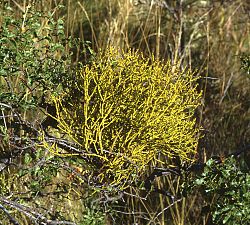| Misodendrum | |
|---|---|
 | |
| Misodendrum punctulatum on Nothofagus antarctica | |
| Scientific classification | |
| Kingdom: | Plantae |
| Clade: | Tracheophytes |
| Clade: | Angiosperms |
| Clade: | Eudicots |
| Order: | Santalales |
| Family: | Misodendraceae J.Agardh [1] |
| Genus: | Misodendrum Banks ex DC. |
| Species | |
See text | |
| Synonyms [2] | |
| |

Misodendrum is a genus of hemiparasites which grow as mistletoes on various species of Nothofagus . Its species are all restricted to South America. The name of the genus is incorrectly spelt in a number of ways, including Misodendron and Myzodendron. [2]
Contents
Misodendrum is placed in its own family, Misodendraceae, in the order Santalales. [1]
These plants have the common name of feathery mistletoes. [3]